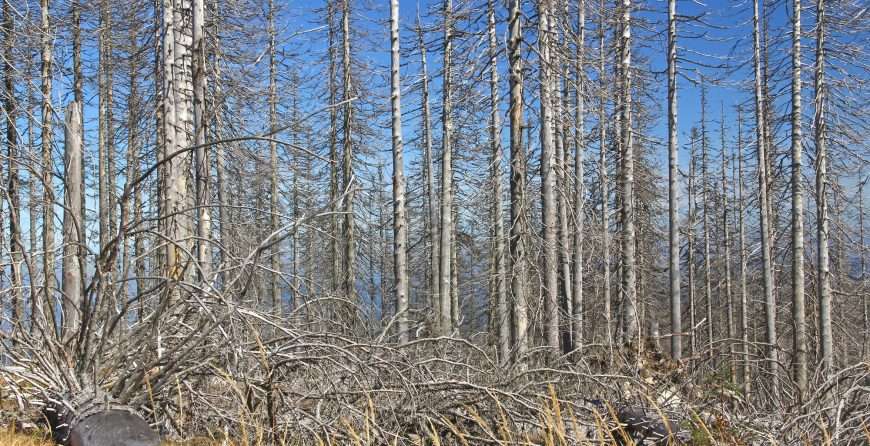Northern Ontario’s vast forests, known for their breathtaking beauty and ecological significance, are facing a serious threat: the invasive spruce budworm. This tiny insect, which feeds on the needles of spruce trees, has triggered a wave of devastation in the region’s forest ecosystems. The consequences are far-reaching, with impacts on biodiversity, forest health, and the risk of catastrophic wildfires. As the spruce trees die off, the question arises: how can we mitigate the damage, restore forest health, and prevent further dangers from fallen trees and wildfires?
The Impact of Spruce Budworm Infestation
The spruce budworm (Choristoneura fumiferana) is native to North America, but its outbreaks have become more severe in recent years. In Northern Ontario, this pest primarily targets spruce and balsam fir trees, causing massive defoliation. The insects hatch in early spring, feeding on the new growth of tree buds and needles. Over time, repeated infestations can severely weaken or kill entire tree stands.
Key Statistics:
- The spruce budworm is responsible for defoliating millions of hectares of forests across Canada.
- In Ontario alone, over 2.4 million hectares of forest have been affected by budworm outbreaks in recent decades.
- Research indicates that budworm outbreaks can reduce forest productivity by up to 50% over several years.
- In some affected areas, the loss of spruce and fir trees has reached 20-30%, with some regions experiencing even higher mortality rates.
The result is a devastating loss of biodiversity as entire tree species die off, altering habitats for wildlife and reducing the ecological health of the forest. Beyond the ecological implications, the dead or weakened trees increase the likelihood of wildfires due to the high volume of dry, flammable wood and needles that accumulate in the understory. These conditions can quickly escalate to uncontrolled forest fires, threatening human communities, wildlife, and the forest industry.
Three Key Solutions to Address the Spruce Budworm Crisis
- Targeted Pest Management ProgramsOne of the most effective ways to combat the spruce budworm is through integrated pest management (IPM). This approach combines biological, mechanical, and chemical methods to control the budworm population without causing harm to the environment.
- Biological control uses natural predators, such as certain species of birds and insects, to reduce budworm numbers.
- Chemical control involves the use of selective insecticides to target budworm larvae, though this is done with care to minimize environmental impact.
- Trapping and monitoring techniques help track budworm populations, allowing for early intervention.
- Selective Cutting and ThinningSelective cutting is a vital strategy to mitigate the effects of spruce budworm damage while improving forest resilience. By carefully removing weakened or dying trees, forest managers can reduce the spread of the infestation and allow the healthier trees to thrive. Additionally, thinning out overstocked forest stands reduces competition for resources, improving tree growth and resistance to pests.
- This approach helps maintain biodiversity by ensuring that a mix of tree species remains in the ecosystem.
- It also reduces the risk of wildfires by removing dead and dry wood that can easily ignite in hot, dry conditions.
- Reforestation and Tree Replacement ProgramsOnce an infestation has been controlled, reforestation becomes essential to restore damaged ecosystems. Replanting with species that are more resistant to budworms or better suited to the changing climate can help maintain the ecological balance of the forest. Native species such as cedar and pine can often thrive in areas previously dominated by spruce and fir, offering an alternative to the monoculture of spruce forests that makes them more vulnerable to pests.
- Diversifying forest composition by planting a variety of species can enhance ecosystem resilience to future pest outbreaks and climate stressors.
The Role of Canada Brush Control in Forest Health
Addressing the spruce budworm infestation and mitigating its long-term effects requires expertise, precision, and proper equipment. This is where Canada Brush Control excels. With over 15 years of experience in selective cutting, land clearing, and forest management services, Canada Brush Control is uniquely positioned to assist with the challenges posed by the spruce budworm crisis.
Why Canada Brush Control is Your Best Choice:
- Expertise in Selective Cutting: Canada Brush Control specializes in selective cutting, carefully removing damaged or pest-infested trees while preserving the health of the surrounding forest. This method helps slow the spread of the spruce budworm and reduces the fuel load that could contribute to wildfire risk.
- Sustainable Land Management: Their focus on sustainable land clearing ensures that each operation is carried out with a long-term vision for forest regeneration and ecological balance.
- Advanced Equipment: Using state-of-the-art equipment, Canada Brush Control can quickly and efficiently clear land, thinning forests and removing dangerous deadwood, reducing the risk of fires and pest spread.
- Wildlife Habitat Preservation: By strategically thinning forests and promoting species diversity, Canada Brush Control helps maintain healthy habitats for local wildlife, even as they address pest problems.
- Risk Mitigation for Wildfires: Through their expertise in land clearing, they not only help combat spruce budworm infestations but also reduce the fire hazard posed by dry, dead trees.
Canada Brush Control’s comprehensive services are an essential part of the solution to protect Northern Ontario’s forests, promote regeneration, and reduce the catastrophic risks posed by the spruce budworm infestation.
The spruce budworm infestation in Northern Ontario is a pressing environmental issue with wide-reaching consequences. However, with proactive management, including pest control, selective cutting, and reforestation, the region’s forests can recover and thrive. By choosing a trusted partner like Canada Brush Control, landowners and forestry professionals can ensure that the necessary steps are taken to protect these vital ecosystems and mitigate the risk of future fires and forest degradation. Through careful stewardship and professional intervention, we can safeguard the forests of Northern Ontario for generations to come.


